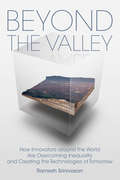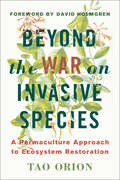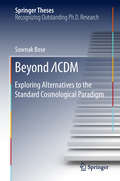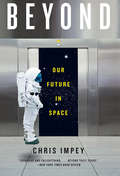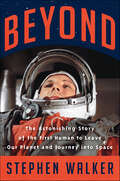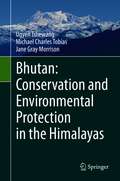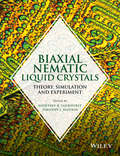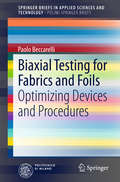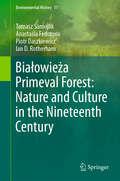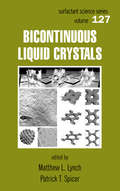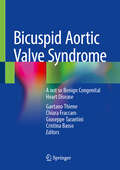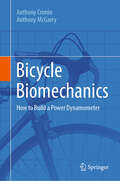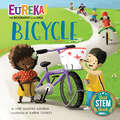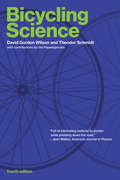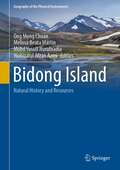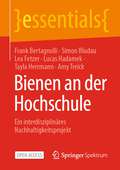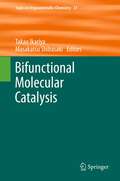- Table View
- List View
Beyond the Standard Model of Elementary Particle Physics
by Yorikiyo NagashimaA unique and comprehensive presentation on modern particle physics which stores the background knowledge on the big open questions beyond the standard model, as the existence of the Higgs-boson, or the nature of Dark Matter and Dark Energy.
Beyond the Valley: How Innovators around the World are Overcoming Inequality and Creating the Technologies of Tomorrow (The\mit Press Ser.)
by Ramesh SrinivasanHow to repair the disconnect between designers and users, producers and consumers, and tech elites and the rest of us: toward a more democratic internet.In this provocative book, Ramesh Srinivasan describes the internet as both an enabler of frictionless efficiency and a dirty tangle of politics, economics, and other inefficient, inharmonious human activities. We may love the immediacy of Google search results, the convenience of buying from Amazon, and the elegance and power of our Apple devices, but it's a one-way, top-down process. We're not asked for our input, or our opinions—only for our data. The internet is brought to us by wealthy technologists in Silicon Valley and China. It's time, Srinivasan argues, that we think in terms beyond the Valley.Srinivasan focuses on the disconnection he sees between designers and users, producers and consumers, and tech elites and the rest of us. The recent Cambridge Analytica and Russian misinformation scandals exemplify the imbalance of a digital world that puts profits before inclusivity and democracy. In search of a more democratic internet, Srinivasan takes us to the mountains of Oaxaca, East and West Africa, China, Scandinavia, North America, and elsewhere, visiting the “design labs” of rural, low-income, and indigenous people around the world. He talks to a range of high-profile public figures—including Elizabeth Warren, David Axelrod, Eric Holder, Noam Chomsky, Lawrence Lessig, and the founders of Reddit, as well as community organizers, labor leaders, and human rights activists.. To make a better internet, Srinivasan says, we need a new ethic of diversity, openness, and inclusivity, empowering those now excluded from decisions about how technologies are designed, who profits from them, and who are surveilled and exploited by them.
Beyond the War on Invasive Species: A Permaculture Approach to Ecosystem Restoration
by Tao OrionInvasive species are everywhere, from forests and prairies to mountaintops and river mouths. Their rampant nature and sheer numbers appear to overtake fragile native species and forever change the ecosystems that they depend on.Concerns that invasive species represent significant threats to global biodiversity and ecological integrity permeate conversations from schoolrooms to board rooms, and concerned citizens grapple with how to rapidly and efficiently manage their populations. These worries have culminated in an ongoing &“war on invasive species,&” where the arsenal is stocked with bulldozers, chainsaws, and herbicides put to the task of their immediate eradication. In Hawaii, mangrove trees (Avicennia spp.) are sprayed with glyphosate and left to decompose on the sandy shorelines where they grow, and in Washington, helicopters apply the herbicide Imazapyr to smooth cordgrass (Spartina alterniflora) growing in estuaries. The &“war on invasive species&” is in full swing, but given the scope of such potentially dangerous and ecologically degrading eradication practices, it is necessary to question the very nature of the battle. Beyond the War on Invasive Species offers a much-needed alternative perspective on invasive species and the best practices for their management based on a holistic, permaculture-inspired framework. Utilizing the latest research and thinking on the changing nature of ecological systems, Beyond the War on Invasive Species closely examines the factors that are largely missing from the common conceptions of invasive species, including how the colliding effects of climate change, habitat destruction, and changes in land use and management contribute to their proliferation.There is more to the story of invasive species than is commonly conceived, and Beyond the War on Invasive Species offers ways of understanding their presence and ecosystem effects in order to make more ecologically responsible choices in land restoration and biodiversity conservation that address the root of the invasion phenomenon. The choices we make on a daily basis—the ways we procure food, shelter, water, medicine, and transportation—are the major drivers of contemporary changes in ecosystem structure and function; therefore, deep and long-lasting ecological restoration outcomes will come not just from eliminating invasive species, but through conscientious redesign of these production systems.&“Beyond the War on Invasive Species is a devastating exposé of the military industrial invasive species complex and a sorely needed and impeccably researched volume that should become one of many as we recover from self-destructive attempts to eradicate parts of nature instead of acting with an understanding of the whole.&”—Ben Falk, author of The Resilient Farm and Homestead and founder of Whole Systems Design
Beyond ΛCDM: Exploring Alternatives To The Standard Cosmological Paradigm (Springer Theses)
by Sownak BoseThis book employs computer simulations of ‘artificial’ Universes to investigate the properties of two popular alternatives to the standard candidates for dark matter (DM) and dark energy (DE). It confronts the predictions of theoretical models with observations using a sophisticated semi-analytic model of galaxy formation. Understanding the nature of dark matter (DM) and dark energy (DE) are two of the most central problems in modern cosmology. While their important role in the evolution of the Universe has been well established—namely, that DM serves as the building blocks of galaxies, and that DE accelerates the expansion of the Universe—their true nature remains elusive. In the first half, the authors consider ‘sterile neutrino’ DM, motivated by recent claims that these particles may have finally been detected. Using sophisticated models of galaxy formation, the authors find that future observations of the high redshift Universe and faint dwarf galaxies in the Local Group can place strong constraints on the sterile neutrino scenario. In the second half, the authors propose and test novel numerical algorithms for simulating Universes with a ‘modified’ theory of gravity, as an alternative explanation to accelerated expansion. The authors’ techniques improve the efficiency of these simulations by more than a factor of 20 compared to previous methods, inviting the readers into a new era for precision cosmological tests of gravity.
Beyond: A Solar System Voyage
by Michael BensonDiscover what the solar system looks like up close in this definitive collection of space exploration images. Since the 1960s, NASA has been sending unmanned satellites to explore the planets, moons, and sun. These probes have amassed a stunning visual record of other worlds, revealing not one but scores of new frontiers, from rust-red Mars to Saturn with its ethereal rings. Michael Benson has pulled together the most spectacular of these images into a volume that focuses on the awesome appearance of these celestial bodies. He discusses what the photos actually reveal about the places in simple language children will understand. The book includes a glossary, a bibliography, and an index. "Dramatic, unframed color photos on thick glossy paper...the science details are just as exciting as the pictures. Starting with a long chapter on the early history of astronomy, Benson examines the Solar System from the perspectives of robot explorers launched in the last 60 years. He also gives in-depth descriptions of how the photos were taken by unmanned spacecraft...The informal text raises the big questions that will captivate young readers: Are we alone in the universe? Has Mars ever supported life? Does life exist there now? Or elsewhere? More than 20 space probes are in action right now, and engaged readers will want to reference the listed Web sites. The comprehensive glossary is also a handy resource. "--Booklist "A mesmerizing grand tour of solar-system high spots. Gathered with the premise that they are significant achievements in the history of not just science, but photography as well, these big, sharply detailed images were all taken by (specifically) space probes and were chosen for their visual impact...the photos range from a primitive 1967 composite shot of the Moon to haunting close-up views of mysterious Neptune and its moon Triton taken by Voyager 2 in 1989...our nearest neighbors in space have never looked better. "--Kirkus Reviews F&P level: Z F&P genre: I
Beyond: Our Future in Space
by Chris ImpeyBeyond dares to imagine a fantastic future for humans in space--and then reminds us that we're already there. Human exploration has been an unceasing engine of technological progress, from the first homo sapiens to leave our African cradle to a future in which mankind promises to settle another world. Beyond tells the epic story of humanity leaving home--and how humans will soon thrive in the vast universe beyond the earth. A dazzling and propulsive voyage through space and time, Beyond reveals how centuries of space explorers--from the earliest stargazers to today's cutting-edge researchers--all draw inspiration from an innate human emotion: wanderlust. This urge to explore led us to multiply around the globe, and it can be traced in our DNA. Today, the urge to discover manifests itself in jaw-dropping ways: plans for space elevators poised to replace rockets at a fraction of the cost; experiments in suspending and reanimating life for ultra-long-distance travel; prototypes for solar sails that coast through space on the momentum of microwaves released from the Earth. With these ventures, private companies and entrepreneurs have the potential to outpace NASA as the leaders in a new space race. Combining expert knowledge of astronomy and avant-garde technology, Chris Impey guides us through the heady possibilities for the next century of exploration. In twenty years, a vibrant commercial space industry will be operating. In thirty years, there will be small but viable colonies on the Moon and Mars. In fifty years, mining technology will have advanced enough to harvest resources from asteroids. In a hundred years, a cohort of humans born off-Earth will come of age without ever visiting humanity's home planet. This is not the stuff of science fiction but rather the logical extension of already available technologies. Beyond shows that space exploration is not just the domain of technocrats, but the birthright of everyone and the destiny of generations to come. To continue exploration is to ensure our survival. Outer space, a limitless unknown, awaits us.
Beyond: The Astonishing Story of the First Human to Leave Our Planet and Journey into Space
by Stephen Walker09.07 am. April 12, 1961. A top secret rocket site in the USSR. A young Russian sits inside a tiny capsule on top of the Soviet Union’s most powerful intercontinental ballistic missile—originally designed to carry a nuclear warhead—and blasts into the skies. His name is Yuri Gagarin. And he is about to make history. <p><p> Travelling at almost 18,000 miles per hour—ten times faster than a rifle bullet—Gagarin circles the globe in just 106 minutes. From his windows he sees the earth as nobody has before, crossing a sunset and a sunrise, crossing oceans and continents, witnessing its beauty and its fragility. While his launch begins in total secrecy, within hours of his landing he has become a world celebrity – the first human to leave the planet. <p><p> Beyond tells the thrilling story behind that epic flight on its 60th anniversary. It happened at the height of the Cold War as the US and USSR confronted each other across an Iron Curtain. Both superpowers took enormous risks to get a man into space first, the Americans in the full glare of the media, the Soviets under deep cover. Both trained their teams of astronauts to the edges of the endurable. In the end the race between them would come down to the wire. <p><p> Drawing on extensive original research and the vivid testimony of eyewitnesses, many of whom have never spoken before, Stephen Walker unpacks secrets that were hidden for decades and takes the reader into the drama of one of humanity’s greatest adventures – to the scientists, engineers and political leaders on both sides, and above all to the American astronauts and their Soviet rivals battling for supremacy in the heavens.
Bhautik Vignan Part-3 class 10 - GSTB: ભૌતિક વિજ્ઞાન ભાગ-3 ધોરણ 10
by NavneetNCERT ના અભ્યાસક્રમ મુજબ ધોરણ 10 ના ભૌતિક વિજ્ઞાન માટેની પાઠયપુસ્તક.
Bhautiki Bhag-1 class 11 - NCERT - 23: भौतिकी भाग-१ ११ वीं कक्षा - एनसीईआरटी - २३
by Rashtriy Shaikshik Anusandhan Aur Prashikshan Parishadभौतिकी भाग 1 11 वीं कक्षा का राष्ट्रीय शैक्षिक अनुसंधान और प्रशिक्षण परिषद् ने पुस्तक हिंदी भाषा में प्रकाशित किया गया है। इस पाठ्यपुस्तक में विज्ञान एवं प्रौद्योगिकी के अन्य क्षेत्रों अथवा दैनिक जीवन में कुछ अनुप्रयोगों को दर्शाना, सरल प्रयोग सुझाना, भौतिकी के विभिन्न क्षेत्रों में अभिधारणाओं में संबंध, एकरसता अथवा नीरसता को तोड़कर पुस्तक को सजीव बनाना है। पुस्तक के प्रत्येक अध्याय के अंत में सारांश, विचारणीय विषय, अभ्यास तथा अतिरिक्त अभ्यास एवं उदाहरण जैसे विशिष्ट लक्षणों को बनाए रखा गया है। संकल्पनाओं पर आधारित कई अभ्यासों को अध्यायों के अंत में दिए गए अभ्यासों से 'उदाहरण एवं उनके हल' के रूप में पाठ्य सामग्री में स्थानांतरित किया गया है। यह आशा की जाती है कि ऐसा करने से अध्याय में दी गई संकल्पनाएँ अधिक बोधगम्य बन जाएँगी।
Bhautiki Bhag-2 class 11 - NCERT - 23: भौतिकी भाग-२ ११ वीं कक्षा - एनसीईआरटी - २३
by Rashtriy Shaikshik Anusandhan Aur Prashikshan Parishadभौतिकी भाग 2 11 वीं कक्षा का राष्ट्रीय शैक्षिक अनुसंधान और प्रशिक्षण परिषद् ने पुस्तक हिंदी भाषा में प्रकाशित किया गया है। इस पाठ्यपुस्तक में विज्ञान एवं प्रौद्योगिकी के अन्य क्षेत्रों अथवा दैनिक जीवन में कुछ अनुप्रयोगों को दर्शाना, सरल प्रयोग सुझाना, भौतिकी के विभिन्न क्षेत्रों में अभिधारणाओं में संबंध, एकरसता अथवा नीरसता को तोड़कर पुस्तक को सजीव बनाना है। पुस्तक के प्रत्येक अध्याय के अंत में सारांश, विचारणीय विषय, अभ्यास तथा अतिरिक्त अभ्यास एवं उदाहरण जैसे विशिष्ट लक्षणों को बनाए रखा गया है। संकल्पनाओं पर आधारित कई अभ्यासों को अध्यायों के अंत में दिए गए अभ्यासों से 'उदाहरण एवं उनके हल' के रूप में पाठ्य सामग्री में स्थानांतरित किया गया है। यह आशा की जाती है कि ऐसा करने से अध्याय में दी गई संकल्पनाएँ अधिक बोधगम्य बन जाएँगी।
Bhutan: Conservation and Environmental Protection in the Himalayas
by Michael Charles Tobias Jane Gray Morrison Ugyen TshewangLocated in the heart of the Eastern Himalayas, Bhutan practices the philosophy of Gross National Happiness (“GNH”) that embraces environmental conservation as one of the main building blocks for its sustainable development goals. Bhutan’s conservation strategies and success are largely driven by the strong political will and visionary leadership of His Majesty the King of Bhutan The nation’s Buddhist perspectives regarding a deep and abiding respect for nature; and the strategic enforcement of a wide-ranging stringent set of internal regulations and controls have helped ensure ecological gold standards in Bhutan. Moreover, the country is an active member of the international conservation community by fulfilling its implementation of various Multilateral Environment Agreements. While it emerged into the 21st century as one of the 36 global terrestrial “hotspots” in biological diversity conservation ranks, Bhutan’s sheer commitment with more than 51% of its territory being managed under the explicit status of a protected area network, and more than 70% of the land under forest cover, represents Bhutan’s exemplary dedication to protect the planet despite its smallness in size and economy, and the biological fragility exemplified by its hotspot situation. In the face of imminent severe threats of global warming, Bhutan nonetheless exemplifies the truth that “a small country with a big conservation commitment” can make an enormous contribution to the global community.At the regional level, Bhutan is intent upon protecting the Water Towers of Asia (that glacial expanse of the Himalayas) which is a critical resource bulwark for about one-fifth of the global population downstream in South Asia. Such protections invariably help mitigate climate change by acting as a nation-wide carbon sink through its carbon neutral policies. In short, Bhutan has long represented one of the world’s foremost national guardians of biodiversity conservation, ecological good governance, and societal sustainability at a period when the world has entered the Anthropocene – an epoch of mass extinctions.We envision this publication to be ecologically and ethically provocative and revealing for the concerned scientific communities, and governments. Through an extensive review of the scientific and anthropological literature, as well as the research team's own data, the Author's have set forth timely recommendations for conservation policies, strategies and actions. This book provides technical and deeply considered assessments of the state of Bhutan’s environment, its multiple, human-induced stressors and pressures; as well as extremely sound, practical techniques that would address conservation strategies in the Himalayas and, by implication, worldwide.
Biaxial Nematic Liquid Crystals
by Timothy J. Sluckin Geoffrey R. LuckhurstLiquid Crystals are a state of matter that have properties between those of conventional liquid and those of a solid crystal. Thermotropic liquid crystals react to changes in temperature or, in some cases, pressure. The reaction of lyotropic liquid crystals, which are used in the manufacture of soaps and detergents, depends on the type of solvent they are mixed with. Since the accidental discovery of the chiral nematic (ordered) phase in 1888 many liquid crystal phases have been found, sometimes by chance and sometimes by design. The existence of one such phase was predicted by Freiser in 1970, this was the biaxial nematic phase which has biaxial symmetry in contrast to that of the ubiquitous nematic phase which ix uniaxial. The biaxial symmetry of the predicted phase confers on it an additional layer of fascinating complexity. This book is devoted to the biaxial nematic phase, both lyotropic and thermotropic, formed by low molar mass as well as polymeric systems. It brings together theory, simulations and experimental studies. The book opens with a general introduction to the biaxial nematic phase, while chapters 2-7 discuss current theories and predictions. Chapters 8 and 9 report on alignment and applications, while chapters 10. 1 -10. 5 detail characterization with the goal of unambiguous identification. Final chapters (11-14) cover Lyotropic, Colloidal, Thermotropic and Low Molar Mass Thermotropic Systems respectively.
Biaxial Testing for Fabrics and Foils: Optimizing Devices and Procedures (SpringerBriefs in Applied Sciences and Technology)
by Paolo BeccarelliThis book offers a well-structured, critical review of current design practice for tensioned membrane structures, including a detailed analysis of the experimental data required and critical issues relating to the lack of a set of design codes and testing procedures. The technical requirements for biaxial testing equipment are analyzed in detail, and aspects that need to be considered when developing biaxial testing procedures are emphasized. The analysis is supported by the results of a round-robin exercise comparing biaxial testing machines that involved four of the main research laboratories in the field. The biaxial testing devices and procedures presently used in Europe are extensively discussed, and information is provided on the design and implementation of a biaxial testing rig for architectural fabrics at Politecnico di Milano, which represents a benchmark in the field. The significance of the most recent developments in biaxial testing is also explored.
Białowieża Primeval Forest: Nature and Culture in the Nineteenth Century (Environmental History #11)
by Tomasz Samojlik Ian D. Rotherham Anastasia Fedotova Piotr DaszkiewiczUnderstanding the current state and dynamics of any forest is extremely difficult - if not impossible - without recognizing its history. Białowieża Primeval Forest (BPF), located on the border between Poland and Belarus, is one of the best preserved European lowland forests and a subject of myriads of works focusing on countless aspects of its biology, ecology, management. BPF was protected for centuries (15th-18th century) as a game reserve of Polish kings and Lithuanian grand dukes. Being, at that time, a part of the Grand Duchy of Lithuania, BPF was subject to long-lasting traditional, multi-functional utilisation characteristic for this part of Europe, including haymaking on forest meadows, traditional bee-keeping and fishing in rivers flowing through forest. This traditional model of management came to an abrupt end due to political change in 1795, when Poland and Grand Duchy of Lithuania ceased to exist in effect of partitioning by neighbouring countries, and the territory of BPF was taken over by the Russian Empire. The new Russian administration, influenced by the German trends in forestry, attempted at introducing the new, science-based forestry model in the BPF throughout the 19th century. The entire 19th century in the history of BPF is a story of struggle between new trends and concepts brought and implemented by new rulers of the land, and the traditional perception of the forest and forest uses, culturally rooted in this area and originating from mediaeval (or older) practices.The book will show the historical background and the outcome of this struggle: the forest’s history in the long 19th century focusing on tracking all cultural imprints, both material (artificial landscapes, introduced alien species, human-induced processes) and immaterial (traditional knowledge of forest and use of forest resources, the political and cultural significance of the forest) that shaped the forest’s current state and picture. Our book will deliver a picture of a crucial moment in forest history, relevant not only to the Central Europe, but to the continent in general. Moment of transition between a royal hunting ground, traditional type of use widespread throughout Europe, to a modern, managed forest. Looking at main obstacles in the management shift, the essential difference in perceptions of the forest and goods it provides in both modes of management, and the implications of the management change for the state of BPF in the long 19th century could help in better understanding the changes that European forests underwent in general.
Bible Truths
by Bob Jones University Press James Frederick CreasonThe fact that materials produced by other publishers may be referred to in this volume does not constitute an endorsement of the content or theological position of materials produced by such publishers. Any references and ancillary materials are listed as an aid to the student or the teacher and in an attempt to maintain the accepted academic standards of the publishing industry.
Bicontinuous Liquid Crystals
by Matthew L. Lynch Patrick T. SpicerWith the development of diverse analytical chemistry techniques, the discovery of rich and numerous properties pertaining to bicontinuous liquid crystal structures has yielded beneficial applications in medicine, consumer products, materials science, and biotechnology. Presenting contributions from 24 experts worldwide, Bicontinuous Liquid Crystals
Bicuspid Aortic Valve Syndrome: A not so Benign Congenital Heart Disease
by Cristina Basso Gaetano Thiene Chiara Fraccaro Giuseppe TarantiniThe objective of this text-atlas is to examine the bicuspid aortic valve syndrome (BAV) holistically. The various chapters deal with epidemiology, morphological spectrum, embryology, associated congenital heart disease, genetics and familiarity, natural history, including clinically relevant valve complications (stenosis, regurgitation, endocarditis) and/or vascular complications affecting the thoracic aorta (dilatation, aneurysm, dissection) that require close clinical follow-up. In addition, multimodal imaging and surgical and transcatheter therapeutic options will be described. To the best of our knowledge, this will be the first illustrated monograph on this topic and will be enriched with numerous original illustrations.Offering in-depth visual representations, clinical insights and comprehensive data, it will provide experts with the tools they need to improve understanding and treatment of this unique heart conition, advancing patient care and research in the field of cardiovascular health.
Bicycle Biomechanics: How to Build a Power Dynamometer
by Anthony Crimin Anthony McGarryThis book is not just for professional cyclists who look to improve their performance on the bicycle. The bicycle is also used in a variety of activities by enthusiasts in commuting; club riding and long-distance solo adventures. By gaining a deeper understanding of the human factors and physiology, cyclists can self-coach to improve their cycling with improved comfort and speed. However, it is often the perception of the cycling enthusiast that the latest frame and component technology play a significant role in rider performance. While this may be true for the professional rider it is because they are biomechanically fitted to their machine. Hence, the purpose of this book is to look beyond the tradition and myth of bicycle setup to help the motivated everyday rider gain a practical understating of the factors that influence their performance. This can be achieved in combination with web-based application tools. If the reader wishes to go further, the book demonstrates a method to build their own power dynamometer to gain an objective measure of their forces (kinetics) of motion. Essentially, by gaining knowledge of cycling biomechanics and measuring and evaluate their own performance, the reader may become their own coach.
Bicycle: Eureka! The Biography of an Idea (Eureka! The Biography of an Idea)
by Lori Haskins HouranWho likes bikes? Just about everyone! Here is a "biography" of bicycles, an essential invention that keeps people rolling!From the first spark of an idea of a new way to get around to the spread of bicycles throughout the world, Bicycle is a fun and informative look at an invention that makes a huge difference in our lives. This STEAM nonfiction title is part of the new Eureka! series with each book focusing on one groundbreaking, world-changing discovery that millions of people use every single day.
Bicycling Infrastructure Design for Indian Cities and Emerging Economies (Design Science and Innovation)
by Debapratim Pandit Deepa SharmaThe book focuses on specific infrastructural solutions for bicycling for Indian cities and other emerging economies. It explores the current state of bicycling infrastructure in Indian cities and proposes standard and custom designs, guidelines, 2D and 3D illustrations, technical drawings as well as relevant discussions and explanations for the choice of right infrastructural solutions according to site constraints. This volume will be of great interest to those in academia and industry dedicated to a vision of creating inclusive streets in Indian cities and emerging economies to making the street safe and comfortable for bicyclists.
Bicycling Science, fourth edition (The\mit Press Ser.)
by David Gordon Wilson Theodor SchmidtAn updated edition of a classic: an indispensable companion for a new era in cycling.The bicycle is almost unique among human-powered machines in that it uses human muscles in a near-optimum way. This essential volume offers a comprehensive account of the history of bicycles, how human beings propel them, what makes them go faster—and what keeps them from going even faster. Over the years, and through three previous editions, Bicycling Science has become the bible of technical bicycling not only for designers and builders of bicycles but also for cycling enthusiasts.After a brief history of bicycles and bicycling that demolishes many widespread myths, this fourth edition covers recent experiments and research on human-powered transportation, with updated material on cycling achievements, human-powered machines for use on land and in air and water, power-assisted bicycles, and human physiology. The authors have also added new information on aerodynamics, rolling drag, transmission of power from rider to wheels, braking, heat management, steering and stability, power and speed, and other topics. This edition also includes many new references and figures.With racks of bikeshare bikes on city sidewalks, and new restrictions on greenhouse gas–emitting cars, bicycle use will only grow. This book is the indispensable companion for a new era in cycling.
Bidong Island: Natural History and Resources (Geography of the Physical Environment)
by Ong Meng Chuan Melissa Beata Martin Mohd Yusoff Nurulnadia Wahizatul Afzan AzmiBidong Island is a small island located in the South China Sea, and is about 14 km from mainland Peninsular Malaysia. The island and the Bidong archipelago boast of its richness in diversity of both terrestrial and marine organisms and its undeniably pristine and thriving ecosystem. In 1975–1990, Bidong Island was formerly a UNHCR refugee camp for a quarter of a million Vietnamese "Boat people" escaping the Vietnam War, and still holds great significance to many of its descendants. Due to its historical significance, the Terengganu State government plans to develop Bidong Island as a heritage tourism site and a new scuba diving destination.This book highlights the uniqueness of Bidong Island and its archipelago, paying particular attention to the biological aspect (which includes marine and terrestrial organisms) and the pollution status surrounding the island. These mainly focus on organisms of the open water and benthic ecosystems such as plankton, fishes, corals reef communities, crustaceans and foraminifera. In addition, we discuss terrene related topics, which includes tree diversity, lichens and also herpetofauna surrounding the Bidong Island. Indisputably an important topic, we also address the pollution status surrounding Bidong Island, with emphasis on heavy metals and its impact.Readers interested in the areas of environmental sciences should find this book appealing. This book can also be used by students and researchers when discussing about tropical environments on island ecosystems. We do hope that stakeholders that would partake in future interest of Bidong Island (particularly in tourism) are equally aware of the current health status of the island and would engage in conserving and sustaining the diversity and heritage of the archipelago for the benefit of the community.
Bienen an der Hochschule: Ein interdisziplinäres Nachhaltigkeitsprojekt (essentials)
by Frank Bertagnolli Simon Bludau Lea Fetzer Lucas Hadamek Tayla Herrmann Amy TreickIn diesem Open-Access-Buch werden verschiedene Erfahrungen vorgestellt, die im Bienenprojekt „BEEsy Mission“ der Hochschule Pforzheim gesammelt wurden. Zukünftigen Projektverantwortlichen wird eine Hilfestellung bei der institutionellen Etablierung und Haltung von Bienen gegeben.Das Buch befasst sich unter anderem mit den Fragestellungen und Herausforderungen, die im Projektkonzept berücksichtigt werden sollten. Es wird erläutert, wie mittels der Durchführung eines derartigen Nachhaltigkeitsprojektes die Interdisziplinarität und das praktische Lernen gefördert werden können.
Bifidobacteria: Methods and Protocols (Methods in Molecular Biology #2278)
by Marco Ventura Douwe Van SinderenThis volume provides current protocols that can be used in various experimental settings involving bifidobacteria. Chapters guide readers through experimental protocols on procedures to isolate and cultivate bifidobacteria, taxonomic identification of bifidobacterial isolates, sequencing and annotate genomes, physiologically characterize bifidobacteria, and methods on the genetic manipulation of bifidobacterial strains. Written in the highly successful Methods in Molecular Biology series format, chapters include introductions to their respective topics, lists of the necessary materials and reagents, step-by-step, readily reproducible laboratory protocols, and tips on troubleshooting and avoiding known pitfalls. Authoritative and cutting-edge, Bifidobacteria: Methods and Protocols aims to be a useful practical guide to researches to help further their study in this field.
Bifunctional Molecular Catalysis (Topics in Organometallic Chemistry #37)
by Masakatsu Shibasaki Takao IkariyaMasakatsu Shibasaki, Motomu Kanai, Shigeki Matsunaga, and Naoya Kumagai: Multimetallic Multifunctional Catalysts for Asymmetric Reactions.- Takao Ikariya: Bifunctional transition metal-based molecular catalysts for asymmetric syntheses.- Chidambaram Gunanathan and David Milstein: Bond Activation by Metal-Ligand Cooperation: Design of "Green" Catalytic Reactions Based on Aromatization-Dearomatization of Pincer Complexes.- Madeleine C. Warner, Charles P. Casey, and Jan-E. Bäckvall: Shvo's Catalyst in Hydrogen Transfer Reactions.- Noritaka Mizuno, Keigo Kamata, and Kazuya Yamaguchi: Liquid-Phase Selective Oxidation by Multimetallic Active Sites of Polyoxometalate-Based Molecular Catalysts.- Pingfan Li and Hisashi Yamamoto: Bifunctional Acid Catalysts for Organic Synthesis.- Jun-ichi Ito, Hisao Nishiyama: Bifunctional Phebox Complexes for Asymmetric Catalysis.

